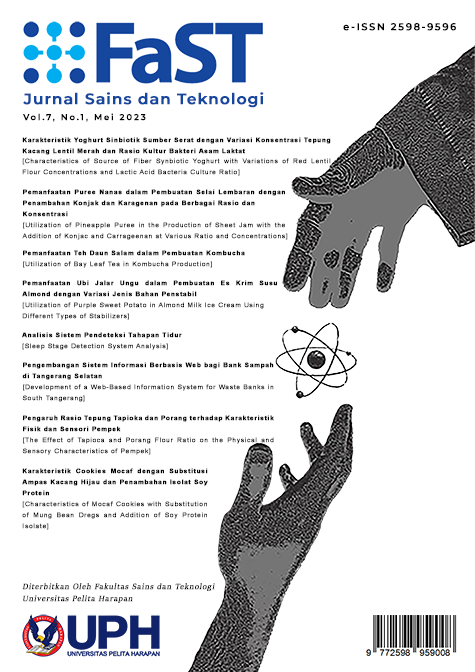PEMANFAATAN PUREE NANAS DALAM PEMBUATAN SELAI LEMBARAN DENGAN PENAMBAHAN KONJAK DAN KARAGENAN PADA BERBAGAI RASIO DAN KONSENTRASI [UTILIZATION OF PINEAPPLE PUREE IN THE PRODUCTION OF SHEET JAM WITH THE ADDITION OF KONJAC AND CARRAGEENAN AT VARIOUS RATIO AND CONCENTRATIONS]
DOI:
https://doi.org/10.19166/jstfast.v7i1.6588Keywords:
carrageenan, konjac, pineapple, puree, sheet jamAbstract
Sheet jam is one of the processed products from pineapple puree. Sliced pineapple jam is a modified product of conventional jam products which generally has to be smeared before use, so it is considered impractical. Sheet jam has a denser texture, is not sticky and does not break when folded. Hence, the correct hydrocolloid ratio and concentration affect the characteristics of the sheet jam produced. This study aimed to determine ratios (1:0, 0:1, 2:1, 1:1, 1:2) and concentrations (1%; 1.25%; 1.5%; 1.75%) konjac with carrageenan on the physicochemical characteristics of sliced pineapple jam. The combination of konjac and carrageenan, at a ratio of 2:1 at a concentration of 1%, is the best ratio and concentration in producing pineapple jam. These sheet pineapple jams have hardness and cohesiveness values of 2337.44 ± 218.612 and 0.80 ± 0.04, respectively. This sheet of pineapple jam has a pH value of 3.73 ± 0.01, so it is included in high-acid food products and has total dissolved solids of 28.70 ± 0.01°Brix. Pineapple jam made with a combination of konjac-carrageenan at a concentration of 1% and a ratio of 2:1 has a yellow colour (80.85 ± 4.60) and a lightness of 46.09 ± 2.80.
Bahasa Indonesia Abstract:
Selai lembaran merupakan salah satu produk olahan dari puree nanas. Selai nanas lembaran merupakan produk modifikasi dari produk selai konvesional yang umumnya harus dioles ketika akan digunakan sehingga dianggap kurang praktis. Selai lembaran memiliki tekstur yang lebih padat, tidak lengket serta tidak mudah patah ketika dilipat sehingga rasio dan konsentrasi hidrokoloid yang tepat berpengaruh terhadap karakteristik selai lembaran yang dihasilkan. Tujuan dari penelitian ini adalah untuk menentukan rasio (1:0, 0:1, 2:1, 1:1, 1:2) dan konsentrasi (1%; 1,25%; 1,5%; 1,75%) konjak dengan karagenan terhadap karakteristik fisikokimia selai nanas lembaran. Kombinasi konjak dengan karagenan pada rasio 2:1 yang dibuat pada konsentrasi 1% merupakan rasio dan konsentrasi terbaik dalam menghasilkan selai nanas lembaran. Selai nanas lembaran ini memiliki nilai hardness dan cohesiveness sebesar 2337,44±218,612 dan 0,80±0,04. pH selai nanas lembaran sebesar 3,73±0,01 sehingga termasuk ke dalam produk pangan tinggi asam dan memiliki warna kuning (80,85±4,60) serta lightness sebesar 46,09±2,80. Total padatan terlarut selai nanas lembaran lebih rendah (28,70±0,01°Brix) dibandingkan dengan SNI 3746-2008 (minimal 65°Brix).
References
Anggreana, R., Fitiana, I., & Larasati, D. (2019). Pengaruh perbedaan proporsi penambahan konjak terhadap sifat fisik, kimia dan organoleptik jeli sari buah anggur hitam (Vitis vinifera L.var Alphonso Lavalle). Jurnal Teknologi Pangan dan Hasil Penelitan, 14(2), 16-29. http://dx.doi.org/10.26623/jtphp.v14i2.2425
Atmaka, W., Nurhartadi, E., & Karim, M. M. (2013). Pengaruh penggunaan campuran karaginan dan konjak terhadap karakteristik permen jelly temulawak (Curcuma xanthorrhiza Roxb.). Jurnal Teknosains Pangan, 2(2), 66-74.
Awulachew, M. (2021). Fruit jam production. International Journal of Food Science, Nutrition and Dietetics, 10(4), 532-537. http://dx.doi.org/10.19070/2326-3350-2100092
Badan Standardisasi Nasional (BSN). (2008). SNI 3746:2008 Selai Buah. Badan Standarisasi Nasional.
Banerjee, S., & Bhattacharya, S. (2011). Compressive textural attributes, opacity and syneresis of gels prepared from gellan, agar and their mixtures. Journal of Food Engineering, 102(3), 287-292. https://doi.org/10.1016/j.jfoodeng.2010.08.025
Bozoglu, T. F., & Erkmen, O. (2016). Food Microbiology: Principles into Practice. John Wiley & Sons.
Brown, A., & Ensminger, H. A. (2015). Understanding Food Principles and Preparation (5th ed.). Canada Press.
Chakraborty, S., Rao, P. S., & Mishra, H. N. (2015). Effect of combined high pressure-temperature treatments on color and nutritional quality attributes of pineapple (Ananas comosus L.) puree. Innovative Food Science & Emerging Technologies, 28, 10-21. https://doi.org/10.1016/j.ifset.2015.01.004
Chandra, M. V., & Shamasundar, B. A. (2014). Texture profile analysis and functional properties of gelatin from the skin of three species of freshwater fish. International Journal of Food Properties, 18 (3), 572-584. https://doi.org/10.1080/10942912.2013.845787
Chaudhary, V., Kumar, V., Singh, K., Kumar, R., & Kumar, V. (2019). Pineapple (Ananas cosmosus) product processing: A review. Journal of Pharmacognosy and Phytochemistry, 8(3), 4642-4652.
Erkmen, O., & Bozoglu, T. F. (2016). Food Microbiology: Principles into Practice. John Wiley & Sons, Ltd.
Fairchild, M. D. (2013). Color Appearance Models. West Sussex: John Wiley & Sons.
GarcÃa-GarcÃa, A. B., Ochoa-MartÃnez, L. A., Lara-Ceniceros, T. E., Rutiaga-Quiñones, O. M., Rosas-Flores, W., & González-Herrera, S. M. (2019). Changes in the microstructural, textural, thermal and sensory properties of apple leathers containing added agavins and inulin. Food Chemistry, 301, 124590. https://doi.org/10.1016/j.foodchem.2019.03.143
Hounhouigan, M. H., Linnemann, A. R., Soumanou, M. M., & van Boekel, M. A. J. S. (2014). Effect of Processing on the Quality of Pineapple Juice. Food Reviews International, 30(2), 112-133. https://doi.org/10.1080/87559129.2014.883632
Ismail, G. H., Yusuf, N., & Mile, L. (2015). Formulasi selai lembaran dari campuran rumput laut dan buah nanas. The NIKe Journal: Jurnal Ilmiah Perikanan dan Kelautan, 3(4), 142-148.https://doi.org/10.37905/.v3i4.1326
Javanmard, M., Chin, N. L., Mirhosseini, S. H., & Endan, J. (2012). Characteristics of gelling agent substituted fruit jam: studies on the textural, optical, physicochemical, and sensory properties. International Journal of Food Science & Technology, 47(9), 1808-1818. https://doi.org/10.1111/j. 1365-2621.2012.03036.x
Kamarul Zaman, A. A., Shamsudin, R., & Mohd Adzahan, N. (2016). Effect of blending ratio on quality of fresh pineapple (Ananas comosus L.) and mango (Mangifera indica L.) juice blends. International Food Research Journal, 23, 101-106.
Kaya, A. O. W., Suryani, A., Santoso, J., & Rusli, M. S. (2015). The effect of gelling agent concentration on the characteristic of gel produced from the mixture of semi-refined carrageenan and glukomannan. International Journal of Sciences Basic and Applied Research, 20(1), 313-324.
Liu, Z., Ren, X., Cheng, Y., Zhao, G., & Zhou, Y. (2021). Gelation mechanism of alkali induced heat-set konjac glucomannan gel. Trends in Food Science & Technology, 116, 244-254. https://doi.org/10.1016/j.tifs.2021.07.025
Parnanto, N. H. R., Nurhartadi, E., & Rohmah, L. N. (2016). Karakteristik kimia dan sensori permen jelly sari pepaya (Carica papaya. L) dengan konsentrasi karagenan-konjak sebagai gelling agents. Jurnal Teknosains Pangan, 5(1), 19 -27.
Pathare, P. B., Opara, U. L., & Al-Said, F. A.-J. (2013). Colour measurement and analysis in fresh and processed foods: A review. Food and Bioprocess Technology, 6(1), 36-60. https://doi.org/10.1007/s11947-012-0867-9
Putri, I. R., Basito, B., & Widowati, E. (2013). Pengaruh konsentrasi agar-agar dan karagenan terhadap karakteristik fisik, kimia, dan sensori selai lembaran pisang (Musa paradisiaca L.) varietas raja bulu. Jurnal Teknosains Pangan, 2(3), 112-120.
Raocaj, O. F., Dimic, E. B., & Vuiasinovic, V. B. (2011). Optimization of the texture of fat-based spread containing hull-less pumpkin (Cucurbita pepo L.) seed press-cake. Acta Periodica Technologica, 42, 131-143. https://doi.org/10.2298/APT1142131R
Septiani, I. N., Basito, B., & Widowati, E. (2013). Pengaruh konsentrasi agar-agar dan karagenan terhadap karakteristik fisik, kimia, dan sensori selai lembaran jambu biji merah (Psidium guajava L.). Jurnal Teknologi Hasil Pertanian, 6(1), 27-35. https://doi.org/10.20961/jthp.v0i0.13502
Siddiqui, N. H., Azhar, I., Tarar, O. M., Masood, S., & Mahmood, Z. A. (2015). Influence of pectin concentrations on physico-chemical and sensory qualities of jams. World Journal of Pharmacy and Pharmaceutical Sciences, 4(6), 68-77.
Sunyoto, R. K., Suseno, T. I. P., & Utomo, A. R. (2017). Pengaruh konsentrasi agar batang terhadap karakteristik fisikokimia dan organoleptik selai murbei hitam (Morus nigra L.) lembaran. Jurnal Teknologi Pangan dan Gizi (Journal of Food Technology and Nutrition), 16(1), 1-7. https://doi.org/10.33508/jtpg.v16i1.1384
Utomo, B. S. B., Darmawan, M., Hakim, A. R., & Ardi, D. T. (2014). Physicochemical properties and sensory evaluation of jelly candy made from different ratio of k-carrageenan and konjac. Squalen Bulletin of Marine and Fisheries Postharvest and Biotechnology, 9(1), 25-34. https://doi. org/10.15578/squalen.v9i1.93
Wong, C. W., Pui, L. P., & Ng, J. M. L. (2015). Production of spray-dried Sarawak pineapple (Ananas comosus) powder from enzyme liquefied puree. International Food Research Journal, 22(4), 1631-1636.
Wulansari, D. (2019). The effect of Comparison of starfruit and carrot porridge on characteristics of sheet jam. Indonesian Food Science & Technology Journal, 2(2), 37-45. https://doi.org/10.22437/ifstj.v2i2.9495
Xiao, H.-W., Pan, Z., Deng, L.-Z., El-Mashad, H. M., Yang, X.-H., Mujumdar, A. S., Gao, Z.-J., & Zhang, Q. (2017). Recent developments and trends in thermal blanching - A comprehensive review. Information Processing in Agriculture, 4(2), 101-127. https://doi.org/10.1016/j.inpa. 2017.02.001
Yuris, A., & Siow, L.-F. (2014). A comparative study of the antioxidant properties of three pineapple (Ananas comosus L.) varieties. Journal of Food Studies, 3(1), 40-56. http://dx.doi.org/10.5296/jfs.v3i1.4995
Downloads
Published
Issue
Section
License
“Authors who publish with this journal agree to the following terms:
1) Authors retain copyright and grant the journal right of first publication with the work simultaneously licensed under a Creative Commons Attribution License (CC-BY-SA 4.0) that allows others to share the work with an acknowledgement of the work's authorship and initial publication in this journal.
2) Authors are able to enter into separate, additional contractual arrangements for the non-exclusive distribution of the journal's published version of the work (e.g., post it to an institutional repository or publish it in a book), with an acknowledgement of its initial publication in this journal.
3) Authors are permitted and encouraged to post their work online (e.g., in institutional repositories or on their website). The final published PDF should be used and bibliographic details that credit the publication in this journal should be included.”



